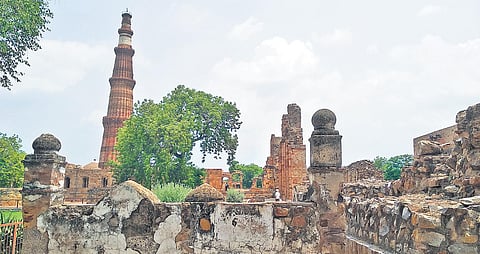

My curiosity killed my paranoia when a few ASI-protected monuments reopened to the public on July 6 after a weeks-long shutdown. On July 10, I chose to visit the Qutub Minar complex that is close to home. Though Google maps show the UNESCO World Heritage site is temporarily closed, it is open from 6:00 am-10:00 pm for anyone with an e-ticket.
As I neared its scalloped entry, the guards (happy to receive the few visitors) guided me through the obstacle course of COVID protocols - chalked social distancing circles, thermal temperature scanner, foot-pedal hand sanitizer, e-ticket scanner, luggage scanner.
At the ‘finish line’, I had to share my contact details; the ASI’s new recordkeeping practice on the daily visitor count. At 1:00 pm, I was visitor No. 38.
I take the concrete path towards the conical fluted minarets, through lush lawns with sweeping boughs of some of other Delhi’s most ancient trees on both sides of the path. On my last visit, by this point tourists had already started miniaturizing the 72.5m minaret using their fingers as calipers to pull at its tip, squish it into a bite-size souvenir, and ‘airpush’ it with the confidence of having moved many mountains before. Without hordes photobombing my view, this new normal is a relief.
The empty COVID-era landscape is reminiscent of the 17th-century aquatints and watercolours by East India Company artists. A case in point is a sketch by artist S Proust for Fisher’s Drawing Room Scrap Book, 1833 (accessible on Wikipedia) with an accompanying poem by English poet and novelist, Letitia Elizabeth Landon (L.E.L). The sketch of two guards in turbans and loin cloth, and battle shields, gazing at the Minar rising from unkempt foliage juxtaposes well with the concluding lines of Landon’s poem:
They who built this lofty tower, which still defies decay,
Must have left many traces; yet not so,
This tower is all, and that has long since lost.
All evidence of former times and men,
It has not one tradition.
Keeping me company are kites, pigeons and squirrels, warm susurrous winds and variegated bird calls, which reach their mellifluous best at the Alai Darwaza - the southern gate of the Quwwat-ul-Islam Mosque.
The space and silence provide privacy and peace to study the Indo-Islamic Afghan elements. The guards are friendly; the one I met, Satish Kumar, directed me to stand under the marbled muqarna for a good angle of the Tomb of Iltutmish, Aibak’s successor. But, the Alai Darwaza, Imam Zamin’s tomb, Ala-ud-din Khilji’s tomb, madrassa and Alai Minar, Gordon Sanderson’s sundial, Smith’s cupola and the bookstore, are cordoned off. “People keep trying to climb up the walls. There’s also social distancing protocol now,” speculates Kumar, adding, “We have to ensure every visitor wears a mask even if they are the only person around.”
I come across Vijay Bahri, busy taking macro shots. His business of water purifiers has hit a lull in the lockdown, so he is indulging in his passion, photography.
“I wanted to feel this empty, deserted look, just as it was in ancient times. This is the best time to capture the monuments without people. Next, I want to visit the Safdarjung Tomb and Humayun’s Tomb.” Rohit Yadav, a product aggregator from Gurgaon, here stalling time before his meeting at Okhla. “I wasn’t scared because I am wearing a mask and carrying a sanitizer, and I knew no one would be around. I enjoyed walking around, undisturbed.”